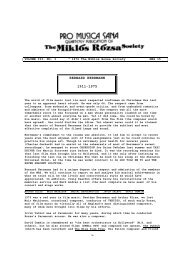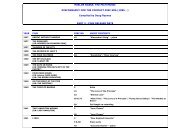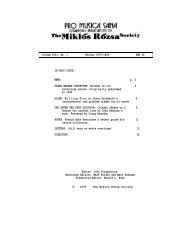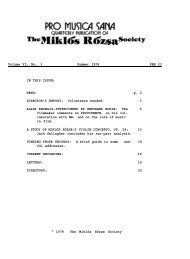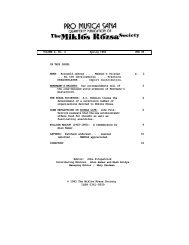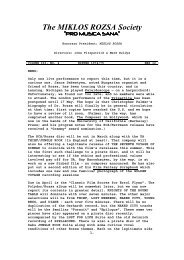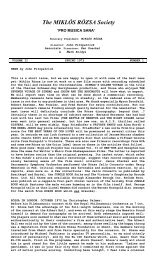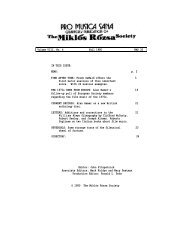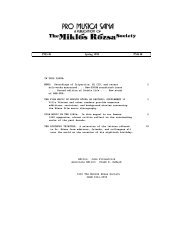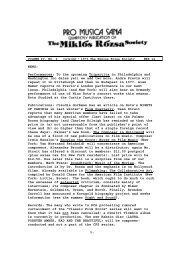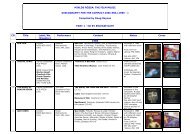Create successful ePaper yourself
Turn your PDF publications into a flip-book with our unique Google optimized e-Paper software.
Volume VIII, No. 3 Summer 1980 PMS 31IN THIS ISSUE:<strong>NEWS</strong>: p. 2WILLIAM ALWYN: Alfons Kowalski offers an intro- 4duction to the life and works of thedistinguished British composer, who is nowcelebrating his 75th birthday.TWO FORGOTTEN SCORES-JERRY GOLDSMITH IN RETRO- 12SPECT: Alexander Strachan's brief forre-evaluations of THE OTHER and THEILLUSTRATED MAN.FILM SMORGASBORD: Tony Thomas's new book, 15reviewed by A. C. Robbins.LONDON AND ANGERS: Alan Hamer's report on M.R.'s 16spring appearances.MIKLÓS RÓZSA, D. M.: The honorary degree cita- 18tion from The College of Wooster.FRANK CORDELL (1918—1980): A tribute by 18Alan Hamer.Editor: John Fitzpatrick AssociateEditors: Mark Koldys and Mary PeatmanProduction Editor: Ronald L. Bohn© 1980 The Miklós Rózsa Society
<strong>NEWS</strong> [September 1980]:Performances:The October Festival International du Cinema of Thonons les Bains (in France,near Geneva) will feature a Rózsa "hommage" consisting of 15 films andperformances of the Duo-Sonata for Cello and Piano, the Sonata for Two Violins,the Sonatina for Clarinet Solo, and the String Quartet.In August Calvin Simmons led the Oakland Symphony in a film music programconsisting of works by Bernstein, Herrmann, Korngold, Waxman, Williams, andYoung.Recordings:The Varese KNIGHTS OF THE ROUND TABLE will be followed by a two-piano albumof film music waltzes by Rózsa.Tony Thomas's personal label has released two new albums, THE LOST WEEKEND andBRUTE FORCE/THE NAKED CITY (TT-MR-2 and MR-3). Like the earlier BLOODON THE SUN (on Citadel), these discs derive from antique acetate transfersof the original studio recordings. The fidelity is therefore limited. Like thefirst "Tony Thomas" album, THE POWER/SODOM AND GOMORRAH, the new records arebilled as "private" releases. They are, however, available through normalretail channels.The latest recording of the SPELLBOUND Concerto (Angel SZ-37757) is the first touse the piano-theremin concert version. Daniel Adni is the pianist with KennethAlwyn and the Bournemouth Symphony Orchestra. Also featured in thisold-fashioned collection of "movie concertos" are the Warsaw Concerto and theCornish Rhapsody.Audiophiles will have an interesting time comparing two new versions of theEntr'acte TIME AFTER TIME recording. Barclay-Crocker has a Dolbyized open-reeltape edition, and Entr'acte is promising a more expensive digital disc version.Information:The new MP/TV Music Credits Bulletin, edited by Ronald Bonn, is an ambitiousattempt to provide a record of all available contemporary composer credits forfilms and television. Each quarterly issue simply catalogues all current releasesfor the three-month period with a brief note on director, cast, and of coursecomposer. The first issue has 360 entries--from Thailand and the Philippinesas well as the U.S. and Europe. Clearly this is a major reference tool forlibraries and serious researchers. The cost in the U.S. is $7. Ronald Bohn'saddress appears on the back page of PMS.For news of a William Alwyn society, see Alfons Kowalski's article later in thepresent issue of PMS.MisinformationIn his "Deadline!" column on the back page of SCN (now retitled Sound track!)David James refers to a record album called Classic Film Music of 20th Century-Fox.The disc, which includes various 1950s scores by Herrmann, Newman, Friedhofer, andWaxman, is said to be the first of a series conducted by one Paul Howarth Asmussenwith the Beaux Art Volksoper of Amsterdam. Readers who have had trouble findingthe disc, and who wonder why an obscure Dutch institution bears a French-Germanname, will be relieved to learn that the entire affair is a fantasy. Jamesaccurately credited the reference to Page Cook's May column in Films in Review,-2-
apparently unaware that Cook frequently invents and discusses fictitious composersand films. A fictitious disc (and conductor and orchestra and record label) issomething else, however, and it is not hard to see how a discographical "ghost"could be created to haunt us for years to come. Caveat lector!The Fictional Rózsa:Gary Swartz has brought to our attention two recent novels in which Miklós Rózsaplays a small role. In John Stanley's World War III (New York: Avon, 1966) thereis a list of old movies that can be used to incite soldiers to a fighting fury.SAHARA is mentioned on page 171, with the comment that Rózsa's score offers ablistering evocation of the hot desert sands. In Stanley's (and Kenn Davis's)Bogart '48 (New York: Dell, 1979) the subject is Humphrey Bogart's foiling of aplot to bomb the 1948 Academy Awards ceremonies. As the hero drives toward the event(late because of some intervening adventures), he listens to the radio: "LarryParks was talking about special-effects artists, and then about music. Originalscores. AlfredNewman for CAPTAIN FROM CASTILE and Max Steiner for LIFE WITHFATHER. He perked up when the name of Miklós Rózsa burst over the radio. Goodold Miklós Rózsa had won for A DOUBLE LIFE. That made up for the Academy nothonoring him in 1943 for his great SAHARA score" (p. 398). This novel also hasBogart playing chess with a cigar-chomping Max Steiner in an earlier scene.Fantastic Film Music:Michael Toman (who incidentally points out that the trailer for MAGIC used notGoldsmith's music but John Williams's for DRACULA) points out that aftermentioning Cinemacabre in our last issue, we neglected to give theaddress. Write to George Stover, P.O. Box 10005, Baltimore, MD 21204. The latestissue of Cinemacabre has additional photographs of Rózsa and Williams togetherwith discussions of the music in TIME AFTER TIME and STAR TREK.Concerning the latter, Steve Vertlieb reports that Goldsmith threatened towalk off the picture when the studio wanted him to imitate the STAR WARS style.Also, he called in Fred Steiner to assist with the later scenes when time wasrunning out because of production problems.An insert with Cinemacabre advertises A Survey of Film Music in the FantasticCinema by Randall Larson. The mimeographed publication is to be over 75 pages longand will contain a checklist, discography, and commentary. Address: FandomUnlimited Enterprises, 774 Vista Grande Ave., Los Altos, CA 94022.Other:The score of TIME AFTER TIME was named as the best of 1979 at the seventh annualScience Fiction Film Awards in June. The film was also honored for script(Nicholas Meyer) and acting (Mary Steenburgen).The Vagabond Theatre of Los Angeles is currently running an extended M-G-Mfestival with a number of Rózsa titles in what are expected to beexcellent prints. Contact the theater for details: 2509 Wilshire Boulevard,Los Angeles, CA 90057.Lee Hern suggests to us that the Warner Bros. TV movie THE MEMORY OF EVA RYKER,telecast last May, had a musical score by Richard La Salle that was surprisinglyclose in places to the TIME AFTER TIME score. Have any other readers noticeda resemblance?(continued on page 19)-3-
WILLIAM ALWYN by Alfons A. Kowalski:There are few film composers who have succeeded in building a reputation as composersof serious music too. Miklós Rózsa, William Walton, Dmitri Shostakovich, and ArthurHonegger immediately come to mind. But with theexception of the first mentioned, none of them has ever been a full-timecomposer of film scores while in addition composing a substantial oeuvre ofsymphonies, concertos, operas, chamber music, and song cycles.William Alwyn, a renowned British film composer for nearly three decades, is one ofthe very few who has been successful in both fields. In this he shares the companyof Miklós Rózsa, both as an artist and as a human being of great integrity who hashad to pay his price for this dual excellence: a general lack of praise for hisconcert music on account of his film background. While the two composers are isolatedindividuals in today's musical circles, there are several features they both havein common: an enormous output of film scores of a generally high level, a highlypersonal and easily recognizable style, and (on a more personal level) a warm andwitty personality Both are also connoisseurs and collectors of paintings. In viewof all this, there is no wonder that Alwyn says about his affinity with Rózsa: "Mikiis a good friend of mine. I admire both his film scores and his serious music. Hehas sent me his scores . . . ours is a mutual admiration."Again like Rózsa, Alwyn is a modern romanticist strongly influenced by his classicalheritage and thus in opposition to contemporary musical currents. So it is hardlysurprising that Alwyn has been sadly neglected in the concert hall until now.Nevertheless he has lately found access to musical circles and has acquired anever-increasing recognition despite those critics who usually turn up their nosesat a composer's film background.William Alwyn is a many-sided creative artist. In addition to his distinguishedcareer, both in the film world and the serious field, Alwyn's further interests seemto be without limit: he is a painter, a connoisseur of English poetry, and a poethimself--a talent that eventually found its way into his song cycles as well asin the librettos for his two operas, Juan; or, The Libertine, based on the Don Juanlegends, and Miss Julie, based on Strindberg's play and recently broadcast bySwedish Radio. Alwyn is also a translator of French literature and a musicologistwith wide and varied new interests. He has been a professor of composition at theRoyal Academy of Music for more than 30 years. Besides all this, he is a skilledconductor. With so many interests to his credit, one really does less than justiceto Alwyn by labeling him a "film composer," as he is too often listed in publicationsof reference. The present article naturally has to focus on Alwyn's serious worksand his film scores; his many other facets will have tobe left to eventual biographers.William Alwyn was born on November 7th, 1905, in Northampton, England. Belongingto a grocer's family (which he claims to have been totally unmusical) he wasdestined to enter his father's business, but he succeeded in escaping the threatof spending his life as a provincial grocer by gaining entry to the Royal Academyof Music as a flautist. He studied harmony and counterpoint but was not allowedto compose until a chance conversation with his flute professor revealed thisdeplorable situation. Horrified, this professor sponsored young Alwyn'sambitions by helping him to transfer to more sympathetic teachers. Soon hebecame a pupil of John B. McEwen, who encouraged the boy's primary interest incomposition. McEwen told Alwyn to throw away his textbooks and to get the scoresof Debussy and Richard Strauss instead. He also introduced him to Schoenberg,Szymanowsky, and Scriabin.-4-
At 18, however his father's sudden death left Alwyn without means of support, andso he was forced to abandon his composition scholarship, leave the R.A.M., andearn his living as best as he could by flute playing in theatres, cinemas, andsymphony orchestras.As a young man, Alwyn's compositional activities were already astonishing: by theage of 30 he had no fewer than 14 string quartets to his credit, as well as a pianoconcerto, a violin concerto, numerous piano works, and a gargantuan secular oratoriofor soloists, double chorus, and enormous orchestra (including organ). Musicpoured out of him in a chaotic torrent. At that time, he says jokingly, his dreamsalternated between stern apocalyptic visions and romantic exile in the SouthSeas!He was in his mid-thirties when he finally realized that his compositional styleseemed to lack consistency and originality and that he could no longer look the greatmasters in the face. For one thing nobody had ever taught him the vital importanceof technique and form. So he abandoned everything he had written hitherto and setto work to study again, this time not at an institution but rather with the scoresof those masters he revered: Liszt, Wagner, Debussy, Puccini, Stravinsky,Scriabin, and Elgar. Realizing that an artist can only learn from the truly great,he did not fear they would leave indelible marks on him, because he firmly believed,and still believes, that originality, or style,does not come by rejection of one'sheritage but through its acceptance--that individuality and style are founded onthe past.Up to that time he had had no special desire to write music for films--not evenwhen occasional engagements as a flute player at film studios eventually led tothe composition of his first film score, a documentary entitled THE FUTURE'SIN THE AIR (1936). But he quickly discovered that composing for films could earnhim a better living and (much more important) could give him the opportunity tohear everything he wrote. As his film scores proved to be more and moresuccessful, he was offered major assignments, and by the end of the 1940s he hadbecome established as one of the leading British film composers.During the war Alwyn was fully occupied in multifarious activities--continual workon propaganda films and broadcasts, teaching at the Academy, flute recitals, andservice as a London air-raid warden--but quite apart from these duties (and severalmajor scores for feature films), he had not abandoned serious composition. Amongstworks composed during the war period were his Concerto Grosso No. 1 and a Concertofor Oboe, Harp, and Strings. When in 1948 he composed his first symphony, Alwynhad an even more ambitious project in mind: he envisaged a cycle of symphonies (notunlike Wagner's operatic Ring.He completed work on his Symphony No. 1 in 1949 and eventually showed his score toSir John Barbirolli, to whom this large-scale work is dedicated. Barbirolli, whoprior to this had conducted a film score of Alwyn's, received the workenthusiastically and conducted the premiere in 1950. He also asked Alwyn for asecond symphony which was soon to follow. Symphonies No. 3 and No. 4 were completedwithin the next few years, thus concluding the composer's idea of a Ring ofsymphonies. Premieres of each of the works were successful, but Alwyn's status asa film composer prevented him from receiving unbiased acclaim; to some of the criticshis symphonies sounded like "film music," perhaps because of the essentiallyromantic style of the works.Many frustrating years of neglect inevitably followed, until in the 1970s theEnglish record company Lyrita (a division of Decca) issued a performance of Alwyn'sSymphony No. 3 (his most spectacular work). This aroused an immediate interest inhis symphonies in both public and critics alike. By 1977 all his symphonieswere recorded (including Symphony No. 5 of 1973), each having-5-
eceived a performance con amore with the composer conducting. In fact, the LondonPhilharmonic Orchestra's response in these recordings is hardly to be surpassed.Alwyn reports that the musicians' acclaim during the recordinq sessions did much tocompensate the composer for the neglect of his music for more than two decades. Alwyn'sattention to the individual part of every instrument in the orchestra makes his worksgrateful to play. This results in performances of great sympathy and musical devotion.By now most of his major symphonic works are recorded, including a Sinfonietta forStrings, a set of Elizabethan dances, a concert overture Derby Day, Concerto GrossoNo. 2 for Strings, a symphonic poem The Magic Island, an Autumn Legend for cor anglaisand string orchestra, and a concerto, Lyra Angelica, for harp and string orchestra.The last is a piece of sheer beauty, as is the Sinfonietta for Strings, a work Alwynwrote as relaxation after six years of hard work on his Don Juan opera.Alwyn's writing is tonal in the sense that he constantly refers to tonal relationsand key-centers. But the material with which he constructs his themes is mostly basedon selected note-rows that may be well compared to Messiaen's 'modes.' Alwyn'ssymphonies are dominated by clear thematic ideas that constantly shift and vary shapeand character, while the basic "rows" (not to be confused with Schoenberg's12-note-rows!) give rise to various unusual key relations. These relations are quitedifferent from classical key relations, which is why one never can say that hissymphonies are "in" D-minor or B-flat.A most striking (and from a formal musical point of view most satisfying) example ofAlwyn's mature symphonic style is his Symphony No. 5 in one movement, which is actuallya complete four-movement symphony in miniature, with different ideas and solutionsto each mini-movement. It needs a true master to compose a piece like this which hasnothing lacking in either intellectual perception or in emotional communication.In addition to his large symphonic oeuvre, Alwyn has written several chamber works,of which his string quartets (not identical with any of the 14 abandoned ones) anda string trio are among his own favorites. He has also composed works for soloinstruments, such as the highly virtuosic Sonata for Piano, a set of Fantasy Waltzesfor piano, pieces for flute, including the brilliant Divertimento for Solo Flute, whichwas given its first performance at the International Contemporary Music Festival heldin New York in 1941, works for harp, and others.Alwyn retired from composing for films in 1960. Like Korngold, he seems to have cometo the conclusion that he must devote the rest of his life to serious music, and thathe could no longer compose "background" music on commission. One has to respect thispoint of view, although the decision is to be regretted by those who dare to envisagewhat he might have done had he continued to pursue his film career. Alwyn'sachievements in his 25 years of composing for films include some jewels of film scoring.To name only a few: ODD MAN OUT, DESERT VICTORY, TUNISIAN VICTORY (with additionalmusic by Tiomkin in the U.S. version), THE MUDLARK, THE CRIMSON PIRATE, and THE RAKE'SPROGRESS. Alwyn was one of the very few British composers frequently offered Hollywoodassignments. He, however, never worked in Hollywood. All of his scores were composedand recorded in England, most of them conducted by the late Muir Mathieson.Alwyn was lucky in having been given carte blanche for most of his film scores. Hewas never typecast as a specialist for certain categories of films. He composed rousingadventure scores (THE CRIMSON PIRATE, MASTER OF BALLAN-TRAE), dramas (ODD MAN OUT,SHAKE HANDS WITH THE DEVIL, the latter being his-6-
only recorded score), comedies (THE MUDLARK and other Alec Guinness films),fantasies (THE ONE MILLION POUND NOTE), and war documentaries (the VICTORY series).Also he did three Disney films (THIRD MAN ON THE MOUNTAIN, IN SEARCH OF THECASTAWAYS, and SWISS FAMILY ROBINSON). As a matter of principle he always did hisown orchestrations, with the exception of the three Disneys, which wereorchestrated by Muir Mathieson. Unlike most British composers, he often tried toavoid full symphonic scoring and created some of his scores for a limited groupof instruments instead. In general he was regarded as a master of orchestrationwho applied his technical resources to the individual requirements of each ofthe films he worked on.Today Alwyn looks back to his film career with slight amusement. He experiencedthe film music boom of the 1940s and 1950s and enjoyed having worked on so manyinteresting films. He has never had any interest in newly recorded versions ofhis film scores. From the point of quality many deserve to be revived, but Alwynobjects strongly to any suggestion that he should make suites of his films scoresand in this respect he differs from most other distinguished film composers. This,alas, is a point of view film music devotees must accept, but anyone knowing Alwyn'smusical integrity (as well as his sincere concern for music in general) willunderstand that he is speaking as a purist. Alwyn never was any sort of showman,and his concern for what is essentially musical is clearly evidenced in his seriousmusic first and foremost.William Alwyn is happily married. His very charming wife, Doreen Mary, is perhapsbetter recognized under her maiden name, Doreen Carwithen, known to connoisseursof film music as one of the very few women composers who worked on films. DoreenCarwithen did several scores for George K. Arthur (ON THE TWELFTH DAY, THE STRANGERLEFT NO CARD), and during the 1940s and 1950s she was assistant to Muir Mathiesonat Denham Film Studios and composed music for a number of documentary and featurefilms. She also worked very closely with Sir Arnold Bax on OLIVER TWIST, anopportunity that she recalls with happy memories.The Alwyns' home, beautifully located at the seaside in Suffolk, East Anglia,contains a wonderful collection of paintings and sculptures that Alwyn hasassembled during his lifetime. Alwyn at 75 is a remarkable personality, full ofenergy and vitality. Alas, he is afflicted with arthritis in his hands, which,he fears, may prevent him from continuing to write further large-scale works. Butvarious chamber works and song cycles are still in prospect. His recent Concertofor Flute and Eight Wind Instruments is a piece of music that reveals memories ofhis youth. He says it came to him like recollections of joy once experienced. Hejust wanted to write a piece of musical beauty. And this is exactly what he hasalways strived for and so often succeeded in: to write music that easilycommunicates with those willing to follow him into a world of aestheticplenitude.William Alwyn is one of the very few true romanticists fighting to maintainsanity in a world of musical chaos. This he shares with Miklós Rózsa. What didAlwyn say about his affinity with Rózsa? "Ours is a mutualadmiration." Don't fail to get acquainted with his music.-7-
William Alwyn filmography:1936: AIR OUTPOST (documentary)THE BIRTH OF THE YEAR (documentary)THE FUTURE'S IN THE AIR (documentary)MONKEY INTO MAN (documentary)THE ZOO AND YOU (documentary)ZOO BABIES (documentary) 1937:THESE CHILDREN ARE SAFE (documentary)WINGS OVER EMPIRE (documentary) 1938:NEW WORLDS FOR OLD (documentary)1939: ROADS ACROSS BRITAIN (documentary)1940: S.O.S (documentary)STEEL GOES TO SEA (documentary)W.V.S. (documentary) 1941: THEHARVEST SHALL COME (documentary)KIPPS [U.S.: THE REMARKABLE MR. KIPPS]PENN OF PENNSYLVANIA [U.S.: THE COURAGEOUS MR. PENN] 1942:THE COUNTRYWOMEN (documentary)LIFE BEGINS AGAIN (documentary)THEY FLEW ALONE [U.S.: WINGS AND THE WOMAN]WALES (documentary)WESTERN ISLES (documentary)WINTER ON THE FARM (documentary)WORLD OF PLENTY (documentary)THE YOUNG MR. PITT 1943:BORDER WEAVE (documentary)CITIZENS OF TOMORROW (documentary)DESERT VICTORY (documentary)ESCAPE TO DANGERFIRES WERE STARTED (a.k.a. I WAS A FIREMAN) (documentary)MEDAL FOR THE GENERALON APPROVALTHE PROUD CITY (documentary)SQUADRON LEADER XTHERE'S A FUTURE IN IT 1944:FRENCH TOWN (documentary)LOST ILLUSION (documentary)OUR COUNTRY (documentary)SOLDIER-SAILOR (documentary)SUMMER ON THE FARM (documentary)TUNISIAN VICTORY (documentary) (co-composer: Dimitri Tiomkin)THE WAY AHEAD [U.S.: IMMORTAL BATTALION]WELCOME TO BRITAIN (documentary)1945: GREAT DAYTHE RAKE'S PROGRESS [U.S.: NOTORIOUS GENTLEMAN]TODAY AND TOMORROW (documentary)TOTAL WAR IN BRITAIN (documentary)THE TRUE GLORY (documentary)1946: GREEN FOR DANGERI SEE A DARK STRANGER [U.S.: THE ADVENTURESS]LAND OF PROMISE (documentary) 1947:APPROACH TO SCIENCE (documentary)CAPTAIN BOYCOTTA CITY SPEAKS (documentary)-8-
OCTOBER MANODD MAN OUTTAKE MY LIFEYOUR CHILDREN AND YOU (documentary)1948: DAYBREAK IN UDI (documentary) ESCAPETHE FALLEN IDOLSO EVIL MY LOVE (with additional music by Victor Young)THREE DAWNS TO SYDNEY (documentary)THE WINSLOW BOY1949: THE HISTORY OF MR. POLLYTHE ROCKING HORSE WINNER1950: THE CURE FOR LOVETHE GOLDEN SALAMANDERMADELEINE THE MAGNETTHE MUDLARKMORNING DEPARTURE [U.S.: OPERATION DISASTER]STATE SECRET [U.S.: THE GREAT MANHUNT]1951: HENRY MOORE (documentary)THE HOUSE IN THE SQUARE [U.S.: I'LL NEVER FORGET YOU]LADY GODIVA RIDES AGAINTHE MAGIC BOXNIGHT WITHOUT STARSNO RESTING PLACEROYAL RIVER (documentary)1952: THE CARD [U.S.: THE PROMOTER]THE CRIMSON PIRATE MANDY [U.S.: CRASH OF SILENCE]ROYAL HERITAGE (documentary)1953: THE LONG MEMORYTHE MALTA STORYMASTER OF BALLANTRAEA PERSONAL AFFAIRPOWERED FLIGHT (documentary) (co-composer: Malcolm Arnold)1954: BLACK ON WHITE (documentary)THE MILLION POUND NOTE [U.S.: MAN WITH A MILLION]THE RAINBOW JACKET THE SEEKERS [U.S.:LAND OF FURY]SVENGALI1955: BEDEVILLEDTHE CONSTANT HUSBAND GEORDIE[U.S.: WEE GEORDIE]THE SHIP THAT DIED OF SHAME (a.k.a. P. T. RAIDERS)1956: THE BLACK TENT SAFARI SMILEY 1957:FORTUNE IS A WOMAN [U.S.: SHE PLAYED WITH FIRE]MANUELA [U.S.: STOWAWAY GIRL]THE SMALLEST SHOW ON EARTH (alternate U.S. title: BIG TIME OPERATORS)ZARAK1958: CARVE HER NAME WITH PRIDEI ACCUSE!A NIGHT TO REMEMBER THESILENT ENEMY-9-
1959: SHAKE HANDS WITH THE DEVILTHIRD MAN ON THE MOUNTAIN 1960:THE KILLERS OF KILIMANJAROSWISS FAMILY ROBINSON 1961IN SEARCH OF THE CASTAWAYSTHE NAKED EDGE1962: LIFE FOR RUTH [U.S.: WALK IN THE SHADOW]NIGHT OF THE EAGLE [U.S.: BURN WITCH BURN]1963: THE RUNNING MAN(Filmography compiled by Ronald L. Bohn and James Marshall.)William Alwyn discography:Film music:DESERT VICTORY ("March: Desert Victory")—H. M. GrenadierGuards Band conducted by Lieut. F. Harris, A.R.A.M.THE RAKE'S PROGRESS ("Calypso Music")—London SymphonyOrchestra conducted by Muir MathiesonCAPTAIN BOYCOTT ("Opening Titles," "Waltz")—PhilharmoniaOrchestra conducted by Muir MathiesonTHE OCTOBER MAN ("Opening Titles and Bus Crash")—LondonSymphony Orchestra conducted by Muir MathiesonTAKE MY LIFE ("Aria")—Philharmonia Orchestra conducted byMuir Mathieson; Victoria Sladen (soprano)CURE FOR LOVE ("Theme)"—London Symphony Orchestra conductedby Muir Mathieson; Sidney Crook (piano)THE HISTORY OF MR. POLLY ("Punting Scene," "The Potwell Inn,""Wedding Scene," "Cycling")—Royal Philharmonic Orch.conducted by Muir MathiesonMADELEINE ("Waltz," "Strathspey")—Royal Philharmonic Orch.conducted by Muir MathiesonTHE ROCKING HORSE WINNER ("There Must be More Money," "Paul'sLast Ride")—Royal Philharmonic Orchestra conducted byMuir MathiesonTHE MAGNET ("Prelude")—Philharmonia Orchestra conducted byby Ernest IrvingNIGHT WITHOUT STARS ("Montage")—Orchestra conducted by MuirMathiesonTHE CARD ("Theme and Variations")—Orchestra conducted byMuir MathiesonTHE LONG MEMORY ("Prelude")—Orchestra conducted by MuirMathiesonTHE MILLION POUND NOTE ("Theme")—Orchestra conducted byMuir Mathieson*78 rpmCol. D82140Dec. K1544Lon. T5054F.M.10F.M.15F.M.21HMV B9879F.M.53-54F.M.100F.M.87-88F.M.101F.M.IllF.M.129F.M.134F.M.144*An annotated listing of these 78 rpm recordings is in the 1957 edition of TheTechnique of Film Music, by Roger Manvell and John Huntley (Focal Press, Londonand New York). The "F.M." numbers were a special series of direct soundtrackrecordings issued by the J. Arthur Rank Organization to record libraries and radiostations but not available commercially.-10-
THE RAINBOW JACKET ("Romance," "The Lingfield Race")—Orchestra conducted by Dock MathiesonTHE SEEKERS ("Dance of Death")—Choir and Orchestra conductedby Muir MathiesonTHE BLACK TENT ("Theme")F.M.150F.M.149F.M.19133-1/3 rpmSHAKE HANDS WITH THE DEVILThe Golden Age of British Film MusicContains "The Punting Sequence" from THEHISTORY OF MR. POLLY; "Paul's Last Ride" fromTHE ROCKING HORSE WINNER; "Main Title" from THECARD (all conducted by Muir Mathieson); plusselections by other composers.UAL 4043 / UAS 5043[Fr.] Sonop. UASF 5043Citadel CT-OFI-1Concert Oeuvre:Symphony No. 1Symphony No. 2 / Sinfonietta for StringsSymphony No. 3 / The Magic IslandSymphony No. 4 / Symphony No. 5 ("Hydriotaphia")Lyra Angelica / Concerto Grosso No. 2 /Autumn LegendElizabethan Dances / works by other BritishcomposersDerby Day / works by other British composersFantasy Waltzes / Sonata alia ToccataMirages (song cycle) / (Divertimento for SoloFlute / Naiades, Fantasy-Sonata for Fluteand HarpString Quartet in D-Minor / String TrioLyrita SRCS 86Lyrita SRCS 85 / MusicalHeritage Soc. MHS 3644Lyrita SRCS 63 / MusicalHeritage Soc. MHS 3300Lyrita SRCS 76 / MusicalHeritage Soc. MHS 3574Lyrita SRCS 108Lyrita SCRS 57 / MusicalHeritage Soc. MHS 1672Lyrita SRCS 95Lyrita RCA 16 (mono)Lyrita SRCS 61 / MusicalHeritage Soc. 1742*Unicorn UNS 241Postscriptum: A society to promote the work of William Alwyn isprojected (in agreement with the composer) and needs support ofmembership. Those interested in Alwyn's music (both serious and filmmusic) should contact the author for further details. Please write to:Alfons A. Kowalski, Heumarkt 2, 6532 Oberwesel / Rhein, West-Germany.* Deleted immediately after release. Very few copies are in circulation.-11-
TWO FORGOTTEN SCORES: JERRY GOLDSMITH IN RETROSPECT byAlexander Strachan:Beneath the warm, golden glitter of a late summer's afternoon in 1935Connecticut, two 10-year-old boys, twins, meet in their secretive lair near theirhome. "Don't worry, little brother," one of them whispers, and a heavy woodentrap door shuts out the twilight. An ominous chord rolls softly beneath theirchatter, heralding the stirrings of an evil presence that will, in the course ofa few short summer weeks, change the course of their lives forever.Jerry Goldsmith's evocative and haunting score for 1972"s THE OTHER provided someof that year's most beautiful music for the screen. It remains to date one ofGoldsmith's finest efforts. Like many worthy scores of that or any other year,it was banished to the vaults of studio libraries along with the film itrepresented, a curiosity, to be resurrected only on late-night television. It wasnot recorded. Like ISLANDS IN THE STREAM, itprobably never will be.It is some, if not much, consolation that this satisfying score has been madeavailable as part of a new series of cassette tapes being offered through theSoundtrack Album Retailers mail order firm. THE OTHER has been paired with themusic from an earlier Goldsmith effort, 1966's SECONDS. Other Goldsmith offeringsin this series worth mentioning include, in stereo, 1977's fine score for theotherwise flat DAMNATION ALLEY, and a film music classic, 1969's THE ILLUSTRATEDMAN.The tapes have been recorded directly off the film prints in question (withdialogue and sound in place) and have been professionally edited together toform a cohesive musical and dramatic statement. The quality of theserecordings varies considerably, from the deep, fine stereophonic resonanceof DAMNATION ALLEY to the occasionally weak moments of THE OTHER,a fuzzy reproduction of whose main title is more than made up for by thereproduction of the score's later and thematically more important moments.THE OTHER, as translated from Thomas Tryon's bestselling novel to the wide screenby director Robert Mulligan (TO KILL A MOCKINGBIRD, BLOODBROTHERS, both scored byElmer Bernstein), is a brooding and enigmatic film. Were it not for the film'soutstanding technical credits. Goldsmith's score among them, the plot would beunintelligible. Tryon's novel employed bizarre narrative twists andpsychological game-playing with the reader, techniques,in this case, adapted to the screen with only limited success.A shy and mournful melody introduces the opening credits, framed on a starkblack backdrop. The theme is whistled at first, then builds to a thrillingyet (because of the unusual orchestration) mysterious orchestral climax,culminating in a shimmering gong that begins the story on a note of qualm. Theopening melody is simple but alluring Americana. Later in the film, for many ofthe scenes between the boy Niles Perry (played alternately and to chilling effectby both Chris and Martin Udvarnoky) and his grandmother Ada (Uta Hagen in her firstscreen role following an impressive career on the stage). Goldsmith develops thismotif with some stunning arrangements: Asimple and beautiful melody suddenly becomes bizarre and menacing. The richorchestrations here are the work of the ever-present, ever-professional ArthurMorton, who enhances Goldsmith's music at every opportunity.A rousing variation of the main title accompanies Niles as he plays "the game,"where his soul follows a crow in flight ("Look at me!"). With majesty and grandeur,this Americana variation builds to an awe-inspiring climax. Suddenly the crowflies too low over a field, a farmer straightens up, a-12-
pitchfork comes from off-screen, jabbing up, toward the oncoming crow--and suddenchords attack the theme as Niles drops to the ground with a gasp, complaining ofa sudden pain in his chest, as though a row of sharp metal prongs had just beenturned quickly and inexorably inside.For Alexandra, the boy's saddened and disillusioned mother, played with a solemn,quietly haunting quality by Diana Muldaur, Goldsmith has created a simple pianoand string duet that heightens her tragic thoughts and represents her withdrawnworld—"Are you hoping?" "Yes, darling, I'm hoping." Here Goldsmith, ever theartist, dares to be subtle. His achievement lies in bringing to this film anemotion it somehow lacks in all its other elements (possibly because of directorMulligan's detached, almost objective directorial style, so different from thesubjective excess of his previous effort, THE SUMMER OF '42). A variation on themother's theme is played to stunning effect in a later scene where Alexandra findsthe fated family ring in her young son's possession (harmonious strings playedquietly and subtly, under-scoring the soft, hushed tones of dialogue). The suddendiscovery is followed by the equally sudden silence that breaks into the musicalrelationship that was developing ever so quietly between the two. Alexandra's ownsudden and bizarre death follows. Here Goldsmith utilizes sound with picture tocreate a truly frightening experience; in this scene more than any other, all theelements of the film are fused to create one single moment of terror.There are moments of beauty and pathos: quiet strings, bells, a piano striking softmoments in leisurely succession as the two boys are playing alone--"What would youlike to see before you die?" "Listen, if I was dyin', I'd be too busy doin' just that,and so would you." Here the quiet scoring flows behind the sound of the breeze rufflingthrough long grass.There are some moments of ugliness and horror: sharp, menacing, angular brass rhythmsdenoting Ada's horrible discovery of a missing baby at the picture's end ("Niles, whereis the baby?"), her equally horrible realization, her decision to kill her oneremaining grandson, all accompanied by the wind of a furious thunderstorm andheightened by fragmentary harmonic chords, a symphony of sight and sound assailingthe senses.The film closes with an unresolved denouement; Goldsmith's score closes with starknakedness, ending with the theme's opening prelude whistled over the end credits.Much has been written and rumored about Goldsmith's use of tonal and atonal effects,but what primarily interests him is not effect so much as dramatics. The themesand dramatics of THE OTHER are underscored with sensitivity and intelligence; onegets the impression this was a score Goldsmith found both challenging andproblematic. Goldsmith's forte is mystery: the more obscure the material, thehigher he seems to rise to the occasion. The enigmatic and often confusing natureof THE OTHER has resulted in some of the best music this fine composer has createdin a long and fascinating career, a career, one would hope, that is far from ended.The titles (my own) and the approximate timings of the musical selections are: MainTitle 1:35 / The Hiding Place 2:38 / Alexandra I 0:59 / Ada--The Game 2:12 / TravelingMedicine Show 3:28 / Running Together 0:45 / Alexandra II 1:45 / What Would You Liketo See Before You Die? 1:48 / Alexandra's Accident 0:49 / Niles Perry 0.38 / Finale(The Baby Lost; The Baby Found; The Fire; End Title) 4:38.Another representative score of this series worth mentioning is 1969's THEILLUSTRATED MAN, adapted by Jack Smight (DAMNATION ALLEY) from the collection ofshort stories by Ray Bradbury. This score, Goldsmith tells Derek Elley-13-
in his recent interview with Films and Filming, "is one of my favorite(s) . .. The style for THE ILLUSTRATED MAN was all my own choice—serial, but lyricalat the same time. There's a close tie between impressionism and serialism, soone can slide back and forth."A strange, brooding song breaks softly behind the opening titles, first a singlesoprano voice, followed by oboe and harp, culminating in the full chamber ensemble.In the opening scene we meet the Illustrated Man, Rod Steiger, introduced by a strangemotif that seems more characteristic of the scores Goldsmith would compose a decadelater for COMA and ALIEN. The theme develops as we learn of the strange misfortuneof the Illustrated Man's skin --Don't you look at those illustrations too long becauseif you do they come alive"--and stranger quest--"Have you seen this house?" "Theremust be hundreds of houses like that around here." "I'm only looking for one, andI'm looking for the lady that lives inside it, and when I find her, I'm going tokill her." The conversation develops; banks of winds and strings rise in orchestralsurges as a crisis looms, the illustrations squirm: "I've told you before, thesethings come alive and when they come alive they scare people, and people don't liketo be scared."We are introduced to the woman of these nightmares, as portrayed by Claire Bloom,and Goldsmith uses a lush, romantic lyricism that foreshadows his fine work in ISLANDSIN THE STREAM nearly a decade later.The scene shifts ahead to a future nightmare; the music flutters, surges, changesswiftly from chamber ensemble to electronic. A web of intrigue is carefully drawn:"What makes you think you can keep me here?" "What makes you think you can go?"The music follows a similar path, turning in on itself as the intrigue thickens,becoming more complicated, the orchestrations varying from moment to moment,employing a full repertory of winds, strings, and percussion, flutes alternatingwith clashing horns, as Goldsmith draws his atonal development to a dramatic climax.This climax is the outstanding feature of this unusual and innovative score: asustained fifteen-minute composition that is an entity unto itself, muted violintextures (signifying the last night of the world) shattered by the sweeping stringchord crescendos of the finale (signifying the death and tragedy born of curiosity).A final washboard stroke sweeps the screen, and the soprano voice returns to concludethe film as it began--with an eerie variation upon a theme of Americana.Throughout, this is Goldsmith at his best, the type of material one has come to expectof his scores for Franklin Schaffner. THE ILLUSTRATED MAN may not be Goldsmith'smasterpiece, but it is certainly one of his most memorable scores.The titles (my own) and the approximate timings of the musical sequences are: MainTitle 3:23 / Meeting the Illustrated Man 2:58 / The Skin Illustrations 2:15 / Felicia3:17 / The Nursery 1:30 / The Veldt 4:30 / She Knew What She Was Doing 2:30 / You'veSeen Her, Haven't You? 1:30 / The Sun Dome 1:02 / I Have To Go 3:28 / Climax andFinale 14:59 (The Last Night in the World 5:06; It Didn't Happen 2:00; See Your OwnFuture and End Title 7:53).(Ed. note: The tapes described here are presumably bootleg recordings, whichis why Mr. Strachan does not give an address or ordering information. The musicremains worthy of attention, which is why he takes this occasion to discuss it.)-14-
FILM SMORGASBORD by A. C. Robbins:Tony Thomas, ed., Film Score: The View From the PodiumCranbury, New Jersey: A. S. Barnes, 1979 (266 pp., $14.50)London: Thomas Yoseloff, 1979Seven years ago Tony Thomas's Music for the Movies was a welcome addition to theliterature of film music. The book was limited to "Hollywood" composers, and itattempted little in the way of musical analysis, stumbling badly whenever it didventure in that direction. But Thomas had gathered a lot of usefulinformation--including accurate filmographies--and he had the grace to standback and let some of the more articulate composers speak for themselves. For theseand other reasons Music for the Movies, still available in hard and soft covers,remains a useful companion. Therefore when it was announced that Thomas's new bookwould consist entirely of interview material, I envisioned a fairly significantitem--perhaps a more honest symposium than the skillful but slanted affair inIrwin Bazelon's Knowing the Score.Unfortunately Film Score is a letdown. Not because Thomas conducts his interviewsbadly, but because he does not conduct enough of them. A certain vagueness in thebook's source acknowledgments makes it hard to be certain, but I doubt that morethan a third of the volume is original material. But let the contents speakfor themselves.Each of the 20 chapters is devoted to a single composer. Predictably the focusis on Hollywood-based composers. The sole and puzzling (though not unwelcome)exception is William Alwyn. The names represented are pretty much those you wouldexpect. Alex North and John Williams are unaccountably absent but this is partlyoffset by the welcome presence of the neglected H. J. Salter and the articulateFred Steiner.Each chapter begins with a short and necessarily superficial biography by Thomas,the sort of material that he put into his earlier book, but that is less usefultoday when we know so much more about the composers than we did in 1973. Afterthese introductions, the composers speak for themselves "on film music." Some fewchapters (e.g., Addison, Bernstein, Fielding, Mancini) appear to derive fromoriginal interview material. The remainder are a varied lot. From Newman andRózsa we get previously unpublished lecture notes. The Herrmann, Korngold,Rosenman, and Tiomkin items have all been published elsewhere, but they would behard to find today and are therefore welcome here. Less justified is the inclusionof Aaron Copland's classic and widely available chapter from What to Listen forin Music. And surely it is indefensible to merely reprint the sleeve notes froma David Raksin album. Anyone interested in Raksin will have these notes already.The contents are as variable as the sources. There is a good deal of livelymaterial--I was particularly impressed by Fred Steiner's essay on the need tounderstand film music--but there is no central focus. The composers do notaddress each other; they do not (as in Bazelon) address common questions andsometimes, thanks to the editing or lack of it, they do not even achieveinternal consistency. The Max Steiner selection, for example, starts out asautobiography, then abruptly shifts in 1936 to a discussion of scoringtechniques.Finally, mention must be made of the atrocious editorial quality of this expensivevolume. Proofreading gaffes are legion: "Rosza," "Bernstin," THE SWAN as a"puritanian" romance. At times one wonders if the book was edited at all:"Bernard Herrmann's place in the history of film scoring is now quite easy toplace." "THE NIGHTCOMERS uses a full orchestra in the romantic fashion."-15-
(Two pages later the composer tells us that his approach was baroque andclassical.) And so on.There is a useful post-1970 discography by Page Cook, and a fragment, now badlydated, from Win Sharples' film music bibliography.Film Score is a smorgasbord with some appealing offerings. It is no bargainthough, and it will not be easy to digest.LONDON AND ANGERS by Alan Hamer:The first week of March was of considerable interest to <strong>Rozsa</strong>philes, affording asit did the opportunity to attend two concerts with the composer conducting his ownmusic, as well as the second National Film Theatre Lecture, which proved as engrossingas the first had, back in 1972. The concerts were in Angers, France, on the 1st and2nd of the month and formed the principal events in an attractively balanced"Festival Cinématographique--Musique et Cinéma," also featuring French composersPiérre Jansen, Antoine Duhamel, Georges Delerue, Francois Bayle, Michel Fano, andothers, plus the affectionately remembered music of Maurice Jaubert.The Orchestre Philharmonique des Pays de Loire was formed in 1971 under MarcelLandowski, and since 1978 its chief conductor has been Marc Soustrot, who wasonce an assistant to Andre Previn with the London Symphony. Rózsa had arrivedin the historic town via London and Paris and was happy to slip away from thebarrage of radio interviewers in the French capital to the delightful Anjouregion, between Le Mans and Nantes, to get down to the serious subject ofmusic-making. He managed to have seven rehearsals with the orchestra, which wasjust as well considering their relative inexperience and unhewn disposition.Rather surprisingly, Soustrot himself conducted the opening Overture to a SymphonyConcert, which leapt into life on the first evening under this young, vigorousconductor but soon sagged noticeably in the development as the brass lost cohesion.However, Soustrot tightened his grip on the proceedings, and the work finished infairly striking fashion. Rózsa was ushered in from the wings of the stage as theapplause swelled appreciably, and when it had died out, he quietly led the orchestrainto the Notturno Ungherese. This blossomed elegantly, and at times the inherentbeauty of the piece radiated, despiteindelicate string playing, as the contours of the music were shaped into ahomogeneous entity.The English pianist, Eric Parkin, was the soloist in Rózsa's Piano Concerto--playingit for the first time--and his typically temperate intensity produced throughoutan ideal balance between sensuous appeal and articulate structure. His calmlydeliberate entry was effective enough but suddenly his concentration seemed to focuswith great clarity, resulting in a memorable first movement. Rózsa strained to keepthe orchestra united with the pianist, but certain players didn't appear to beobserving the conductor at all. In the slow movement Parkin's approach was gentlyreticent, although well poised and with just the right tinge of reflectivemelancholy. The finale came over with much verve and really is an exciting movementto witness in live performance with its many-levelled variations interplayingbetween soloist and orchestra. Parkin obviously enjoyed himself and admittedafterwards that he liked the work immensely.-16-
The concert's second half was devoted to film music and was predictably moresuccessful than the first as the orchestra's shortcomings seemed less noticeableand therefore distracted to a lesser degree. The BEN-HUR Suite, reduced to fourmovements, was rewarded by spontaneous audience enthusiasm after each part. Twoexcerpts from films noir followed (DOUBLE INDEMNITY and THE NAKED CITY, both asarranged on the Polydor records) and were as unevenly played as the preceding suitehad been successful. But matters improved again when Eric Parkin reappeared to playthe waltz from PROVIDENCE to full string accompaniment. The effect was magical.The strings lacked sheen and resonance, but Parkin preserved a sense of intimacywhile often suggesting a larger scale of utterance.Unfortunately, Parkin had not had sufficient time to learn the SPELLBOUND Concertowhich followed, so the equally familiar orchestral version was rendered with theunfamiliar addition of an Ondes Martenot. This sound resounded menacingly aboutthe small theatre, creating a true feeling of panic and hysteria, in contrast tothe theremin's eerie wail, which might tend to more effectively conjure up acutepsychotic disturbances. In any event, this performance would seem to have been a"first," and Dr. Rózsa admitted that he had found the instrument most convincing.The last scheduled item was the MADAME BOVARY waltz and here again the orchestrawas just not up to the swaying intricacies of the piece. In fact, on Sunday a trumpetplayer missed a complete bar and threw the climax night-marishly out of joint!Nevertheless, they somehow all finished together, and the clamorous audienceinsisted on an encore. The finale to TIME AFTER TIME (in French, C'fiTAIT DEMAIN)was the result, and what a splendid addendum to the programme it made; powerfullythrilling, it emerged as the perfect curtain closer, happily rounding off an unevenlyperformed but highly enjoyable pair of concerts--the first ever to be conducted bythe composer in France. Let us hope there are many more.Just three days after the Angers concerts, Miklós Rózsa made his long awaited returnappearance on stage at London's N.F.T., seven-and-a-half years since the firstinterview there. This time the evening began with a showing of MADAME BOVARY, anevent in itself as the film is very rarely seen in England. I am happy to say thatinterviewer Derek Elley informed this writer of the lecture long before it occurred,so every European MRS member could be notified well in advance. About a quarterof the entire U.K./European membership turned up--including four from Germany andtwo from Belgium--all of us eagerly assembling in the bar before the film began.For illustrating the lecture itself, Elley had chosen just four film clips, eachsingularly imaginative: KING OF KINGS (Intermezzo, followed by the first ten minutesof the film); LUST FOR LIFE; THE JUNGLE BOOK (another rarity); plus the last tenminutes of THE NAKED CITY.The discussion centered around Rózsa's M-G-M career, as the lecture formed part ofa massive tribute to M-G-M by the N.F.T. Some notable discourses revealed Rózsa'sproblems composing KING OF KINGS so soon after BEN-HUR, the initial appointment in1948, director-producer relationships in Hollywood, the decline of M-G-M Studios,and also his early film years with Korda. Before the talk. Dr. Rózsa had visitedthe clubroom briefly and soon attracted an eager gathering of enthusiasts who hadcome well armed with record sleeves to be signed. Several days later, he agreed tomeet MRS members at his hotel over tea and a half-dozen contented souls enjoyed anall-too-brief three-and-a-half hours to round off a uniquely distinguished andsatisfying week.-17-
MIKLÓS RÓZSA, D.M.:Last June, The College of Wooster (Ohio) conferred anhonorary degree on Miklós Rózsa (see PMS 28). Following isthe text of the official citation read at the ceremony byPresident Henry Copeland. It was made available to us byJeffrey Dane.Sir, your music is played, loved, and respected in the great concert and recitalhalls around the world. Our foremost orchestras and leading soloists haveperformed it enthusiastically, and the public has responded by acclaiming you asthat comparative rarity--a 20th-century composer whose music is at once seriousand widely appreciated. The musical public has expressed its gratitude withnumerous prizes and awards, and your fellow cinema artists have recognized your rarequalities and honored you with three Academy Awards.Your inspired work as a composer has immeasurably enriched our world, and theprocession of your splendid creations has given us cause to celebrate our humanity.Your consummate skill, unfailing sensitivity, impeccable technique, and profoundoriginality have brought a new musical language to the American public, and therange of your talents, from the spectacularly beautiful violin concerto for Heifetzto the eerie and haunting score for THE LOST WEEKEND, is astounding. You haveavoided cliches and created your own idiom, and the freshness, vitality, andhonesty of your work have been both a revelation and an inspiration to othercomposers and to your audiences.You are an artist and a professional. We are grateful for the integrity andrichness of your work as an artist, for your willingness to examine with ourstudents at Wooster the task of the serious musician in our day, and for yourpatience and imagination as a teacher.By the authority vested in me by the State of Ohio, and by the vote of the Facultyand the Board of Trustees of The College of Wooster, it is my privilege to conferupon you, Miklós Rózsa, the degree, Doctor of Music, honoris causa.FRANK CORDELL (1918-1930) ATRIBUTE by Alan Hamer:The distinguished and versatile composer Frank Cordell died on 6th July at hisSussex home, after a short illness. He was 62. Having begun orchestrating andconducting in the RAF, he assumed the role of overall musical director for ForcesRadio soon after the war.Composing for BBC Radio plays and documentaries soon followed, and in 1955 hejoined EMI's HMV label as a highly successful conductor and arranger of popularsongs and standards, his name appearing on hundreds of "singles" as well as onLP "mood" albums.Cordell began composing for films in the late 1950s (THE CAPTAIN'S TABLE; and thenin Hollywood, FLIGHT FROM ASHIYA). Later, more notable films included KHARTOUM,RING OF BRIGHT WATER, and CROMWELL. His television credits included THE MAN WHONEVER WAS and 26 one-hour episodes of COURT MARTIAL. His last film assignment wasfor Larry Cohen's GOD TOLD ME TO (1976), from which he assembled a concert suite.During his later years he composed a number of concert works----18-
unfortunately little performed--including a piece for saxophone quartet,a celloconcerto (1978), a horn concerto (1979), and Diversions for four horns.His various musical talents were always expertly fashioned to produce original andmemorable results; in fact, he was the true professional in a fickle professioncontaining an excess of amateurs. His musical legacy will be prized by many.<strong>NEWS</strong> (continued from page 3):Special thanks to Mary Ellen Fitzpatrick for entering our mailing lists on a Lexitron1303 Word Processor, thus enabling us to insert changes and additions in properalphabetical sequence. Lexitron Corporation is a division of Raytheon.Finally a late bulletin: Miklós Rózsa will score EYE OF THE NEEDLE, based on KenFollet's best-seller. The World War II thriller stars Donald Sutherland in a storyabout a Nazi spy's attempt to uncover the 1944 Normandy invasion.LETTER:HANSJORG WAGNER, Saarbriicken, West Germany:In 1966 a German picture was produced in two parts, DIE NIBELUNGEN 1 and 2. Thefilm was horrible in almost every way, but the music by composer-conductor RolfWilhelm is among the best ever written for a German film. Epic in construction andmoving in its various themes, it is often reminiscent of Rózsa.Now a new record company called Limelight has recorded the music for the first timeon an excellent stereo LP, the composer conducting the FFB-Orchestra of 80 men. Therecord contains music from the first part of the film. The second part will appearin February, together with the music from another Wilhelm film, VIA MALA. In the53 minutes of music there are interesting reminiscences of Tiomkin ("Der Kampf mitdem Drachen"), Herrmann ("In der Schmiede"), and especially Rózsa ("Marsch derNibelungen," "In Alberichs Hohle"). There are also typical Wilhelm touches in thepastoral "Volker's Erzahlungen," the gigantic landscape "Island," and the splendid"Einzung in Worms." It is hard to believe that this is the first album of a Wilhelmscore and that it took 14 years for the NIBELUNGEN music to be recorded.Limelight Records is a mail order firm with many interesting records from Italy,Germany, and France. The prices are lower than some other firms. The NIBELUNGENrecord is $12.50 plus $3.50 for surface shipping or $6.50 for air mail. Address:Quallenbrunnen 15, D6601 Sitterswald, West Germany.-19-
In an old PMS there was a remark that the "Notturno" from Background toViolence is not taken from BRUTE FORCE (as the liner notes claim) but from THEKILLERS. Actually only the beginning and end are from THE KILLERS; the middlesection is the love theme of Joe Collins and Ruth from BRUTE FORCE. The new recordTT-MR-3 proves this, as the ominous side two contains the Background to Violencesuite also, and not the announced music from THE NAKED CITY.The LOST WEEKEND record is also interesting. The "Walk Along Third Avenue" istotally different from the film version and the Polydor album. Perhaps analternative composition? The finale seems to follow the film version, then goesinto a variant just before the end titles. There have been previous instancesof this sort of thing, of course. The PLYMOUTH ADVENTURE finale on the M-G-M /Polydor album is completely different from the version in the film.Our apologies for this late summer issue. The fall issue ought tofollow shortly with Frank DeWald's TIME AFTER TIME analysis. Afterthat we expect Ronald Bohn's Rózsa film music discography, MichaelQuigley's essay on CLOSE ENCOUNTERS OF THE THIRD KIND, and, we hope,some reviews of current scores.PMS DIRECTORY :INQUIRIES, SUBSCRIPTIONS:EDITORIAL MATERIAL, POLICY MATTERS:TAPE RECORDINGS:EUROPEAN REPRESENTATIVE:WEST COAST REPRESENTATIVE:MARY PEATMANJOHN FITZPATRICK319 Ave. C, No. 11-H NewYork, NY 10009MARK KOLDYS7545 Manor Dearborn,MI 48126ALAN J. HAMER86 Bow LaneFinchley LondonN12 OJP UnitedKingdomRONALD L. BOHNP. O. Box 3599Hollywood, CA 90028



